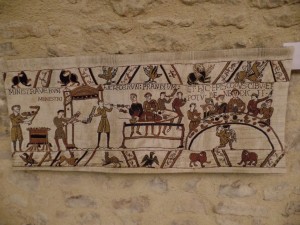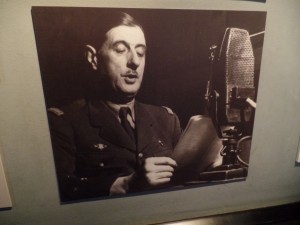One amazing sight in the French city of Bayeux, in Normandy, is the Bayeux Tapestry. Hundreds of knights on horseback, animals both real and mythical, sailing ships and woody forests, along with Latin inscriptions, march along this remarkably detailed embroidery of colored wool to depict scenes from the Norman Invasion of 1066. It shows William the Conqueror’s reasons for going to war, the preparations made for the crossing, and the Battle of Hastings in 1066 from a Norman perspective. The inspiration for the tapestry was likely Bishop Odo of Bayeux, William’s half-brother, who ordered the tapestry to celebrate both the Norman invasion of England and the completion of Odo’s cathedral. In addition to the historical details of war, the tapestry includes borders lined with scenes from Aesop’s Fables such as the fox and the crow. Scholars have debated the meaning of these scenes, and some suggest that the British embroiderers expressed their protest of Norman rule by including these stories of deceit and theft on the tapestry.



During the Middle Ages, the Normans ruled Bayeux because of the raids of their Viking ancestors. According to the Tapestry, Duke William was the official successor to Edward the Confessor, since Edward had no heirs and had spent 30 years in exile in Normandy. Harold Godwinson, Edward’s brother-in-law, broke his oath to Duke William, motivated by a lust for power and a desire to protect his kingdom from Norman domination. Regardless, Duke William invaded England and defeated Harold at Hastings after he was shot in the eye by an arrow. French became the language of the court, and Norman nobility became the new land- owning aristocracy of England. This important event changed the relationship between France and England forever.



Normandy’s coast has been the site of many battles. Almost 900 years after 1066, on June 6,1944, the D-Day invasion brought Allied troops to these shores. Though the coastal towns endured heavy bombardment, Bayeux was amazingly spared from extensive damage. British troops and their American allies had come to liberate France. Just as the Bayeux Tapestry is a reminder of the wars of the Medieval era, Arromanches, part of the temporary ports that the English set up at Gold Beach after gaining a beachhead, is a reminder of the terrible sacrifice of the Allies who died in regaining French territory. Part of this mulberry harbor can still be seen in the ocean. Apparently, this logistical operation, like much of D-Day, was incredibly chaotic. Critical supplies were left aboard ships for many hours because of misplaced manifests, and supplies were brought on shore randomly.



Caen, a major city and center of regional railroad networks, suffered the worst bombing. The Caen Memorial Museum documents the history of WWII through the end of the Cold War. Here there is further visual evidence of the suffering of the French people through four years of German occupation. While the French did not experience the bombing or mass casualties of the Russians on the Eastern Front, the country was still a broken nation. German authorities forced the French to work in their factories and ordered rationing on mass scale. Although Charles de Gaulle put forth the “myth of the resistance,” the claim that all French people, actively or passively, were involved in resistance against the Germans, the museum shows both collaborationists’ and resistance members’ arguments concerning German occupation.


As an American, I am both humbled and proud to visit the American Cemetery that honors the sacrifice of American soldiers who were killed on D-Day and subsequently in the invasion of the continent. Almost 10,000 servicemen of the Army, Army-Air Corps, and Navy died. I walked solemnly through this cemetery, where our study group placed 13 flowers on Buckeye (Ohio State) graves. These members of our OSU family served their nation and the world at a moment when terror reigned. I found out that President Theodore Roosevelt’s son is buried there as well. He was the only general to lead the invasion of Utah Beach on the beach itself during the invasion.



Today, we can watch grainy newsreels of the Allies as they approached the beaches of Normandy under heavy fire from the German artillery that was dug in along the Norman shore and share the fear of those who leap from the boats onto the sand. Perhaps we have similar emotions as those who passed along the Bayeux Tapestry, watching the Battle of Hastings unfold in colored thread. Battles across the centuries keep our attention. Bayeux and the beaches of France hold the reminders of so many lives cut short as nations struggle for power.